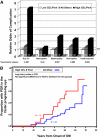Protection from retinopathy and other complications in patients with type 1 diabetes of extreme duration: the joslin 50-year medalist study
- PMID: 21447665
- PMCID: PMC3064059
- DOI: 10.2337/dc10-1675
Protection from retinopathy and other complications in patients with type 1 diabetes of extreme duration: the joslin 50-year medalist study
Abstract
Objective: To assess complication prevalence and identify protective factors in patients with diabetes duration of ≥50 years. Characterization of a complication-free subgroup in this cohort would suggest that some individuals are protected from diabetes complications and allow identification of endogenous protective factors.
Research design and methods: Cross-sectional, observational study of 351 U.S. residents who have survived with type 1 diabetes for ≥50 years (Medalists). Retinopathy, nephropathy, neuropathy, and cardiovascular disease were assessed in relation to HbA(1c), lipids, and advanced glycation end products (AGEs). Retrospective chart review provided longitudinal ophthalmic data for a subgroup.
Results: A high proportion of Medalists remain free from proliferative diabetic retinopathy (PDR) (42.6%), nephropathy (86.9%), neuropathy (39.4%), or cardiovascular disease (51.5%). Current and longitudinal (the past 15 years) glycemic control were unrelated to complications. Subjects with high plasma carboxyethyl-lysine and pentosidine were 7.2-fold more likely to have any complication. Of Medalists without PDR, 96% with no retinopathy progression over the first 17 years of follow-up did not experience retinopathy worsening thereafter.
Conclusions: The Medalist population is likely enriched for protective factors against complications. These factors might prove useful to the general population with diabetes if they can be used to induce protection against long-term complications. Specific AGE combinations were strongly associated with complications, indicating a link between AGE formation or processing with development of diabetic vasculopathy.
Figures




Comment in
-
Comment on: Sun et al. Protection from retinopathy and other complications in patients with type 1 diabetes of extreme duration: the Joslin 50-Year Medalist Study. Diabetes Care 2011;34:968-974.Diabetes Care. 2011 Sep;34(9):e148; author reply e149. doi: 10.2337/dc11-0971. Diabetes Care. 2011. PMID: 21868772 Free PMC article. No abstract available.
References
-
- Shaw JE, Sicree RA, Zimmet PZ. Global estimates of the prevalence of diabetes for 2010 and 2030. Diabetes Res Clin Pract 2010;87:4–14 - PubMed
-
- The Diabetes Control and Complications Trial Research Group The effect of intensive treatment of diabetes on the development and progression of long-term complications in insulin-dependent diabetes mellitus. N Engl J Med 1993;329:977–986 - PubMed
-
- Cruickshanks KJ, Ritter LL, Klein R, Moss SE, The Wisconsin Epidemiologic Study of Diabetic Retinopathy The association of microalbuminuria with diabetic retinopathy. Ophthalmology 1993;100:862–867 - PubMed
-
- Chew EY, Klein ML, Ferris FL, 3rd, et al. Association of elevated serum lipid levels with retinal hard exudate in diabetic retinopathy: Early Treatment Diabetic Retinopathy Study (ETDRS) Report 22. Arch Ophthalmol 1996;114:1079–1084 - PubMed
Publication types
MeSH terms
Substances
Grants and funding
LinkOut - more resources
Full Text Sources
Other Literature Sources
Medical
Miscellaneous

